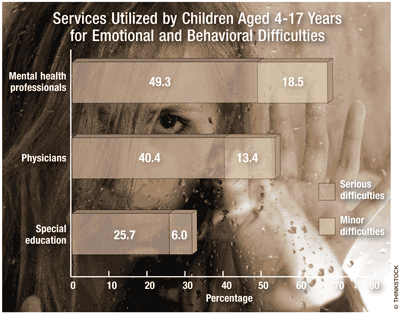US Pharm. 2013;38(11):8.
Annually, according to CDC data, 13% to 20% of children aged 12 to 17 years develop a mental disorder. The interaction of mental disorders with other factors can result in suicide, which in 2010 was the second leading cause of death in children in this age group. The Healthcare Cost and Utilization Project reported that mood disorders were among the most common principal diagnoses for all hospital stays among children and accounted for an 80% increase from 1997 to 2010 (jumping from 10 to 17 stays per 10,000 population). Forty percent of children with one mental disorder developed at least one other mental disorder. The 2007 National Survey of Children’s Health assessed the presence of mental health problems or conditions, namely, emotional and behavioral difficulties.

Depression: Treatment for depression was sought by 25% more girls than boys. About 39% of youths aged 16 to 17 years and those aged 14 to 15 years received treatment for at least one major depressive episode, in contrast to 32.7% of youths aged 12 to 13 years. Children who did not live with either parent were most likely to experience emotional and behavioral difficulties (36.6%), followed by those who lived with their mother only (30.6%), lived with their father only (22%), or lived with both parents (18.2%). There was a significant discrepancy in the increase of serious emotional and behavioral difficulties among children who lived with only one parent (mother-only families, +118%; father-only families, +16%).
Anxiety: Anxiety disorders experienced by children were specific phobia (19.3%), social phobia (9.1%), separation anxiety (7.6%), posttraumatic stress disorder (5%), bipolar disorder (2.9%), agoraphobia (2.4%), obsessive-compulsive disorder (2.3%), panic disorder (0.4%), generalized anxiety disorder (0.3%), and childhood-onset schizophrenia (0.014%). Thirty percent more boys than girls experienced anxiety (3.4% vs. 2.6%). With progression of age, a 190% hike was observed between children aged 2 to 5 years and those aged 6 to 11 years, although the rate of increase decreased appreciably among those aged 12 to 17 years (41%).
Oppositional Defiant Disorder: Oppositional defiant disorder was reported in 4.6% of boys aged 3 to 17 years and in 2.2% of girls in the same age range. The prevalence increased with age (age 3-5 years, 1.3%; age 12-17 years, 4.2%). The prevalence decreased with higher household educational attainment (less than high school education, 6.1%; more than high school education, 2.5%) and increases in household income (7.3% vs. 2%), but was similar regardless of whether or not the child had insurance coverage or which region of the country the child lived in (both, 3.4%).
To comment on this disorder, contact rdavidson@uspharmacist.com.





